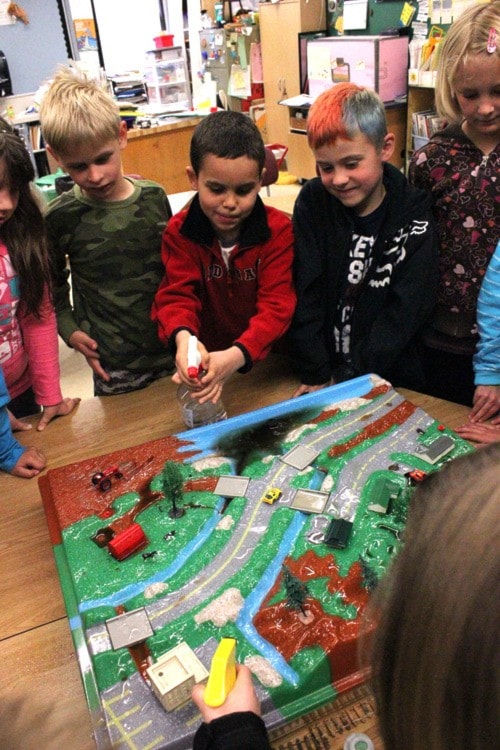Lake Cowichan Salmonid Enhancement Society president, Bob Crandall, along with Kai Rietzel from the Cowichan Land Trust, were at Palsson Elementary on April 11, educating students about local watersheds and the effects of pollutants and litter in Lake Cowichan waterways.
Crandall and Rietzel spent about an hour with students in Mrs. Walter’s Grade 2 class, first educating them about pollution and how garbage and other pollutants such as oil, gas, herbicides and pesticides can get into the Cowichan River and other local waterways, through storm drains. “The presentation brings public awareness, participation and education together with a hands-on model of a watershed. Students learn about the substances in and around our lives that can become pollutants and what can be done to prevent pollution,” says Crandall.
Crandall had the students gather around what he calls an Enviroscape model of the town and demonstrated how a good rainfall can carry pollution down roads, in ditches, and through storm drains to a water supply. The children got to watch as Crandall sprinkled simulated pesticides, herbicides, and drops of oil onto the model. They were then given spray bottles (which they had to share), and were told to create a rain storm on the town. The result was a black/brown river of “contaminated” water that made its way from the highest points of the model, down to the simulated lake or water source.
It was at this point that Rietzel took over. After the kids were once again settled in their seats, Rietzel talked to them about marking storm drains with a salmon shaped stencil, and why it is important to let house owners and community members know not to pour pollutants down storm drains. The kids then got to watch a short one or two minute video on the subject, complete with a fun and catchy rap song. The video depicts students wearing bright, reflective vests going out into their community to mark storm drains and educating their neighbours about the dangers of pollution.
Near the end of May, or the early part of June, Crandall will be accompanying students as they hit the streets and mark storm drains with the yellow salmon icon. The Lake Cowichan Secondary School students helped him mark local storm drains in 2010.
Crandall says he makes yearly presentations to all of the schools in the Lake Cowichan area, but he is also available by request. The presentations are adjusted to fit the audience, and Crandall offers them to adults, for special events, and to boy scouts and girl guides. He feels that “educating the youth about pollution prevention is important because this generation could possibly be the last generation that will have a chance to make a significant difference with the environment and we cannot allow this opportunity to pass us by.”
Crandall has given watershed pollution presentations from the gulf coast of Louisiana to Vancouver “and all points in between” since 2003.
